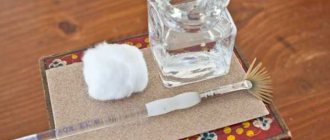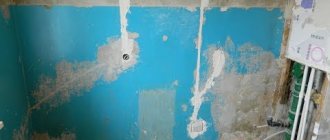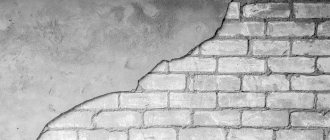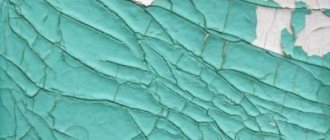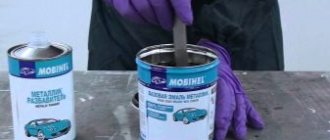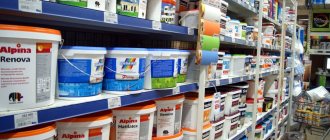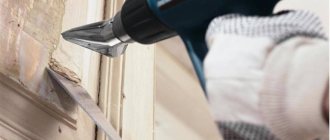Painting wood with water-based paint: recommendations for surface treatment
Natural-based building materials remain the most popular, and many are interested in whether it is possible to paint wood with water-based paint. Painting a surface with a wood texture has its own secrets, thanks to which it is possible to preserve the specific texture of the wood. Water-based compositions can be used for painting wood due to their special consistency.
Water-based paint, its properties, in what cases it is used for wood
Repair work and construction are the main areas of application of water-dispersed compositions. The compound H2O, known to everyone from chemistry lessons, is the basis of water-soluble dyes, to which pigments and some other binding components are added. They are necessary for better adhesion (adhesion) to the surface being painted and obtaining an even protective layer.
The wood dries after processing. The molecules of the main component of the paint replace natural water molecules:
- when painting tree bark with water-based paint;
- in finished products when coloring the characteristic wood texture.
This treatment does not harm tree trunks, since it does not form an impenetrable polymer film, like other dyes.
Note! When painting fruit trees with water-based paint, lime is added to it. This is necessary to repel pests and rodents.
Knowing the composition, proportions and method of obtaining water dyes, you can make a similar mixture with your own hands for whitewashing garden trees - based on chalk, white clay, lime. In order to increase viscosity, modified additives and thickeners are introduced into the finished composition. Factory-made water emulsion for wood also fits well on the old lime mortar that was previously used to treat the fence and tree trunks.
When whitewashing a residential attic is required, water-based paint is often used to coat wooden beams and building materials joining them:
- foam concrete blocks;
- brickwork;
- plywood panels;
- plastered surfaces.
In interior design this is one of the most popular coatings. Decor specialists do not have a very large selection of “breathable” enamels that can absorb and release moisture.
Stage I: Barrel Cleaning
Mosses and lichens have settled on many adults, especially on old trunks and the bases of lower skeletal branches. The bark is cracked and peeling. All this needs to be cleaned off. Experienced gardeners have special devices, but you can get by with improvised means.
The best methods of cleansing are gentle ones: with hands wearing fabric gloves or with a homemade “washcloth” made from plastic twine rolled up in several layers.
Cleaning is carried out in wet weather. Cracks and depressions are treated with a wooden knife or even a sharpened sliver so as not to injure the trunk. Proponents of this approach are categorically against metal brushes, scrapers and scourers. And even more so against cleaning with a hoe or saw blade, which can seriously injure the tree. Other gardeners have been using them for years and consider this the norm. It’s up to you to choose, the main thing is to follow the principle “Do no harm.”
In any case, before cleaning the trunk, you need to spread an oilcloth or thick cloth under the tree. Peeled moss, lichens, pieces of bark and the contents of cracks where pests have found a winter refuge fall on it. All this will need to be taken away from the trees and burned.
And here is a practical video tutorial on caring for fruit tree trunks:
Types of water-based paints suitable for wood
Water-based paint, from the point of view of chemistry and physics, is an ordinary solution filled with binding components and pigment. From the information in the previous section, it became clear that wood can also be painted with water-based emulsion.
When purchasing a package, it is important to carefully study all the information. A large segment of the paint and varnish products market consists of:
- water-dispersed (acrylic, latex, etc.) compositions;
- water emulsions.
The difference in the structure and physical and chemical processes of coloring mixtures:
- A water-dispersed solution contains a suspension of insoluble solid particles in a liquid. Water evaporates during surface treatment, particles with pigment form a stable structure. They adhere well to vertical and ceiling surfaces. An example is whitewashing trees with lime mortar.
- Emulsion is a dense suspension of multi-molecular pigment and thickener in a ready-to-use form. Water does not react with the insoluble oily base. After application, when H2O molecules evaporate, a film resistant to mechanical damage is formed.
A well-chosen composition is designed to ensure high-quality adhesion to the surface being treated.
What is the peculiarity of façade water-based paints?
Classification of water-based paint compositions offered in construction supermarkets and catalogues:
- water-based wood paint for interior work;
- façade dyes (coatings for external treatment of vertical surfaces).
Compositions for external use are most resistant to temperature changes, moisture, ultraviolet radiation, and natural pollution. It involves additional inclusions:
- antifreeze antifreeze;
- fungicides that prevent the formation of fungi and mold on the surface of wood;
- thickeners (to ensure thick consistency and dense coverage);
- fire-fighting components so that the paint does not support the combustion process.
Important! When purchasing, you need to clarify which variety the preferred coloring composition belongs to. This will ensure flawless operation of the treated wood surface.
Types of water-based compositions
Experts can name up to a dozen varieties of dyes that contain water. Main classification:
- Acrylic paint is widely used in the interior to cover various surfaces, including wood slats. Durable, elastic, one of the components is a resinous substance, this is an emulsion.
- The silicone composition includes high molecular weight elastic compounds in H2O solution.
- Mineral emulsion based on light cement and slaked lime, suitable for gardening and painting construction projects. It is rarely used, since in many respects it is inferior to most modern formulations with modified additives and stabilizers.
- Silicate paint, simple in composition and method of hardening, is a solution of liquid glass with pigment. Application - for outdoor use, physico-chemical properties ensure resistance to adverse weather conditions.
Note! Wood can be painted with water-based paint - emulsions provide a loose structure with sufficient water and air permeability.
Dispersions, including acrylates, are a good choice for protecting and improving the aesthetics of wood products. They are characterized by a suitable consistency and high adhesion to the surface.
Methods of applying paint to wood
To perform finishing work with water-based materials, you can use a spray gun, roller or brush.
The spray gun is preferred in cases where large areas need to be treated. Pros of this tool:
- The coating is smooth;
- The time required for wall treatment is minimal;
- It is possible to paint even the most complex surface areas without using a brush;
- The material is consumed in less volume (compared to the manual method).
Using a paint roller creates a slightly thicker layer, so you may need fewer coats of paint to achieve the desired effect.
The disadvantages of this method of wood processing include: relatively low productivity (compared to the previous tool), energy consumption, and the difficulty of painting hard-to-reach areas.
The process of painting with a brush is quite labor-intensive, and the consumption of material is much higher, since the paint does not apply evenly on wood. Therefore, when painting large areas, it is recommended to use a brush in combination with a roller.
Advantages and disadvantages of water-based wood paint
The environmentally friendly water-based composition often makes the use of this variety the only possible one. Water-based emulsion is recommended for repairs in children's rooms and the personal space of allergy and asthma sufferers.
Water-dispersed solutions have unlimited possibilities for obtaining the required color. You can add color (a special water-soluble pigment) of the desired shade to them.
Advantages of water emulsion for woodworking
Water-based coatings are distinguished by a number of excellent characteristics, due to which they are included in the segment of the most popular paint and varnish products. Advantages:
- absence of toxic components;
- the surface “breathes” (air penetrates, moisture is absorbed and evaporates);
- the film on the surface looks unstable, but lasts for many years;
- if necessary, to obtain a more liquid consistency, dilute with plain water;
- thanks to added pigments of varying concentrations;
- a suspension available for household use, applied with a spray gun, brush or roller;
- does not require ventilation, good ventilation is sufficient;
- when working indoors, water-based paint for wooden surfaces can be used in any season;
- the painted surface can be cleaned, washed and repainted;
- does not cause irritation upon contact with exposed skin, just wash with soap;
- a long period of flawless operation is guaranteed, even when treating the external surface;
- when used correctly, the coating has no defects;
- environmental friendliness of components;
- affordable price.
Disadvantages of using water-based emulsions
It is impossible not to mention the weaknesses of water-based coloring mixtures:
- a composition that is too liquid can lead to slight deformation due to the swelling of overdried wood;
- the coating has some vulnerability to moisture, so it is better not to use it in rooms with excess steam and moisture;
- has poor adhesion to smooth surfaces and requires preliminary sanding and primer coating.
Technology for whitewashing trees in autumn with water-based emulsion
Whitewashing trees with water-based paint in the fall is needed not so much for aesthetics, but to protect fruit trees from adverse weather conditions. Unlike lime-based solutions, which are traditionally used in gardening, paints and varnishes are not washed off by precipitation and remain on the bark until spring.
Find out how to defeat trees with water-based paint.
Features of the material
In hardware and construction stores you can find different compositions for painting wood, made on a water basis. Most of them relate to water-based and water-dispersion paints (acrylic, latex, etc.). Despite the general principle of manufacturing these materials, they differ from each other both in composition and in the final result of coloring.
Emulsions and dispersions
Water-based paint is created by the forced combination (dispersion) of two immiscible liquids. One is water, the other is a suspension of tiny particles of polymers and a coloring pigment: titanium dioxide, chalk or lime. When dried, the material forms a thin breathable film with an emulsion of polymer components.
Water-dispersion paint is a type of water emulsion that is bound with polyvinyl acetate, acrylic or latex components to give it additional properties.
After drying, the composition forms a coating more resistant to precipitation than water-based paint.
Advantages and disadvantages
The advantages of water-based paints include their environmental friendliness, low toxicity and ability to pass air. In winter, the tree “breathes” through the pores of the bark, so the breathability of the paint is an important condition for the normal functioning of the plant. The disadvantage of coloring emulsions is their relatively weak resistance to precipitation.
Water-based paint and varnish dispersions stay on wood longer due to binding components and form a denser coating that reliably protects fruit crops from frost cracks and spring sunburn. The disadvantages of this material include their low vapor and air permeability, which can lead to the growth of fungi and lichens under the film and subsequent rotting of the bark.
Preparatory steps before painting
For high-quality work, preparation must be carried out before painting. All rules and instructions must be followed:
- Firstly, you should wash or clean the surface from dust and dirt, greasy stains of old coating or mold. These steps can be performed using a cleaning solution and clean water.
- Calculate how many kg of material per m2 is required. The material consumption depends on this.
- If the walls or ceiling have deep dents or cracks, they must first be repaired with plaster mortar.
How to apply water-based dispersion paint yourself
- The surface must be leveled with plaster and then coated with a primer.
- Places where mold or mildew has formed must be treated with a special antifungal agent.
- If the surface is wet, it needs to be dried.
- The wooden surface should be sanded so that it is as smooth as possible.
How to paint trees
Whitewashing is carried out in dry weather so that rain or snow does not wash away the fresh paint. In mature trees, the trunk (the lower part of the trunk) and the thick (skeletal) branches adjacent to it are whitened. These parts of the plant are the most vulnerable: they cannot recover when damaged, as roots or young shoots do.
Seedlings and young plants 1-2 years old are not painted to avoid damage to the thin, delicate bark. If necessary, resort to other measures to protect against frost, burns and rodents: tying with spruce branches or covering material, installing fine mesh.
Preparing trunks for processing
The trunk of apple, plum, pear and other fruit trees needs to be cleaned and disinfected before autumn painting.
This procedure is performed to prevent fungal infections of wood and to better fix the coloring composition on the bark.
Preparatory work is carried out in several stages:
- Burlap or a piece of thick fabric is spread under the crown.
- Using a plastic or wooden scraper, clean the trunk of mosses, lichens, and dry fragments of bark.
- A disinfectant solution prepared from copper sulfate, stove ash, green soap, or a ready-made industrial composition is applied to the cleaned surface.
- Large cracks, damage, and hollows are cleaned and sealed with garden varnish.
- If necessary, remove dry branches and trim the crown.
To prevent the spread of pathogenic microorganisms throughout the garden, the protective fabric is burned along with the garbage. It is better to do this outside the site.
Methods of applying paint to wood
It is more convenient to apply paint from top to bottom: this avoids smudges. The layer should not exceed 2 mm in thickness so that the wood can “breathe”.
The trunks are whitened with the following tools:
- Paint brush. For work, choose a wide, flat brush with artificial bristles. Adult plants can be painted with poppy seed, as it allows you to immediately cover a large area of bark.
- Spray gun. This method is suitable for those who have many fruit trees growing in their garden. The spray gun economically consumes paint and varnish material, applying it in an even thin layer.
- Paint roller. With this tool, paint is applied quickly, easily and evenly. However, it is not able to cover hard-to-reach areas as well as a brush. Therefore, whitewashing with a roller is recommended for smooth trunks without visible damage.
Whitewashing is carried out in October-November after the end of the period of autumn showers and the air temperature drops to -2...-3°C.
Source: vmirekraski.ru
Painting tools
When whitewashing plants with lime mortar, sponge brushes were usually used in the past. At present, they have practically been abandoned, using tools with artificial bristles of a similar shape to apply the compositions. They are in no way inferior to their predecessors, allowing you to quickly and efficiently paint any surface. Particularly resourceful gardeners carry out the treatment with several brushes tied together.
If you have to whitewash a large number of trees, especially old ones, then it would be wise to use a spray gun for this. In this case, it is necessary to apply the composition in two layers instead of the usual one.
What surfaces can be painted with water-based emulsion?
Water-based compositions for wooden surfaces are produced on the basis of PVA and latex. Both compositions are made from natural raw materials. Depending on the content of a particular component that is chosen as the basis of the material, we can talk about the scope of application and the result obtained.
PVC-based paints and white glue go well with wooden surfaces. The composition dries in just a few hours, after which a thin film coating is formed on the wood, the floor is matte, the structure is porous.
Paint based on butane-diene-styrene polymer compounds is easy to use. Available in the form of a paste, diluted before use. There is no smell, the surface is smooth and pleasant to the touch. Most often used to create interior interiors.
Water emulsion for wood
Paintwork materials can be used not only for interior and exterior decoration, but also to protect trees. Painting trees with water-based paint helps protect the wood from cracking under the influence of high humidity and destruction from temperature changes.
For these purposes, alkyd, alkyd-oil or simply oil compositions are often used. It is important that the bark breathes. Therefore, PVC-based paints and varnishes are most often used to seal branch cuts and protect them from pests.
A separate question is whether it is possible to paint fruit trees with water-based paint. Most often they are treated with lime, which should be renewed every year, since the composition is quickly washed off. Sometimes you even have to paint it twice a year.
Currently, manufacturers have developed a special composition - special latex paint, which lasts longer. But whether it is worth using water-based emulsion is still being debated. The fact is that the film formed on the surface does not allow the bark to breathe, and many experts consider this harmful to the growth, development and fruiting of the tree.
Experience shows that the use of water-based compositions does not cause harm, but more often lime is still used for these purposes. Whether to paint the tree with water-based paint or prefer another treatment is up to the garden owners to decide on their own.
Lining finishing
The lining has an interesting wood structure in appearance, and often does not need painting. But in certain cases it is better to cover it with paint and varnish. Water-based paints give the surface a pleasant matte tint, but do not hide the grain of the wood. The advantages of using this composition include the fact that it is not inferior in protection to varnishes.
It is preferable to paint the lining with water-based paint when thin boards are used for interior and exterior decoration of the house. Paintwork materials are also used in situations where the lining has lost its visual appeal. Water-based paint will preserve an interesting texture and will not hide knots or wood fibers.
Affordable price, cleanliness, moisture resistance, fire safety and other positive qualities are the main advantages that make water-based paint an attractive option for finishing wooden surfaces.
Source: kraskaok.ru
Acrylic water dispersion paint purpose:
Water-dispersion acrylic paint for garden trees, weather-resistant. After using this paint, you can move on to painting facades, and for this there is facade paint based on Finnish acrylate styrene.
— therapeutic and prophylactic painting of trunks and bases of skeletal branches in order to increase the winter hardiness of the bark of fruit and ornamental plants;
- protecting them from sunburn and frost damage (rupture of the bark under the influence of a large temperature difference);
— disinfection of trunks and branches, destruction of pests;
— protection from rodents and hares;
- covering the cuts after pruning in the garden and nursery.
Acrylic paint, water dispersion, consumption:
Saplings, young trees - 50-70g, fruit-bearing trees - 180-200g. for a single layer coating.
State registration of the Eurasian Economic Community
Environmentally friendly product
All products have certificates and are environmentally friendly.
Water dispersion acrylic paint storage:
Store in a tightly closed container at a temperature not lower than +5C
State registration of the Eurasian Economic Community
View the entire range of acrylic water dispersion paints.
Sales department /
High-quality paint for garden trees is important in the life of gardeners. It is intended for whitewashing and protecting trees from small rodents, hares and other tree bark lovers. Whitewashing is often used for this purpose, but in the modern world there are better methods that quickly and effectively cope with the task. Those who have tried acrylic paints for garden trees no longer return to old methods of plant protection. It is much easier to buy paint for garden trees for the season than to experiment with dubious drugs and substances.
All about whitewashing trees in spring
Why are trees whitewashed? The bark plays an important role in the life of a plant; it protects its internal tissues from mechanical damage, as well as negative effects from a number of other negative factors. These include temperature fluctuations, winds, insects and rodents settling around. It is not difficult to guess that this is why the main function of whitewash is protective. In particular:
- during periods when the tree is deprived of natural protection in the form of foliage (autumn and early spring), it protects the trunk from bark burns;
- destroys the larvae of harmful insects located inside the bark;
- prevents the appearance of microcracks on the surface of the bark.
Why are tree trunks younger than 5-6 years old whitened and is it really necessary? This issue has been causing a lot of controversy for years. Could the mixture used cause the thin bark to burn and stop its growth?
In fact, the possibility of deformation of the bark under the influence of the composition of the mixture used in the process is quite likely, but this risk can be minimized by reducing the concentration of lime in it. In addition, as an alternative to a mixture containing aggressive components, you can use a silver biomask, water-based paint or acrylic.
For your information! The damage caused to the bark by sunburn is disproportionately greater than that which whitewashing can cause to it.
When to whitewash trees
To achieve optimal results, whitewashing of trees is carried out three times a year at the specified time:
- the first whitewashing, which is also the most important, is carried out in the fall from September to November;
- the second time - at the end of February or beginning of March;
- Once again, the whitewashing is renewed in July.
Work on whitewashing wood
Why are trees whitewashed and why exactly on this schedule? Such measures are explained by the fact that the first days of February and the beginning of March are considered the most dangerous. During this period, the trunk heats up enough for sap flow to begin inside it during the day, and at night, when the air temperature drops, the liquid freezes. This increases the risk of internal tissue rupture and microcracks.
The white color of the mixture is not accidental: it effectively repels the sun's rays and does not allow the temperature inside the tree to heat up above the necessary level. Due to the fact that the plant treated in this way awakens a little later. It will also be protected from spring frosts.
When are fruit trees whitened?
Gardeners with extensive experience whitewash trees at least 3 times throughout the year: in early spring, summer and autumn. The main and most important whitewashing is autumn. It is better to do it at the onset of the first frost, that is, approximately in mid-October.
Whitewashing done in the fall will protect trees from:
- from the formation of ice on the bark
- from pests that have settled in the bark and infections of fungal origin
- to some extent - from voracious hares (it has been verified that they do not like lime-covered bark)
In cases where, for some reason, whitewashing the garden in the autumn was not successful, it can be done in February. This time period is especially dangerous for the plant: the bark, heated during the day to +10 C, causes the onset of sap flow, and night temperatures, which can be below -10 C, cause deep freezing of the trunk.
Thus, the sap turns into crystals, which severely injure or tear wood tissue. The result is the appearance of very deep cracks in the plant bark.
The surface treated with whitewash reflects the sun's rays and warms up much more slowly. Consequently, awakening from hibernation begins only when a real warm spring comes and the possibility of night frosts is practically absent.
The autumn whitewashing carried out during the period does not exclude repeated processing in the last ten days of March.
Summer whitewashing is generally carried out only in cases where, during the time that has passed since the previous one, natural factors, that is, rains, have washed away the previously applied composition. If the treatment was carried out with a leave-in composition, summer treatment, in principle, can be omitted. To carry out garden processing work, it is advisable to choose a quiet and warm day.
How to whiten tree trunks
What is the best way to whiten trees? Each mixture has its pros and cons. Lime is convenient to use for whitewashing because it is environmentally friendly and relatively inexpensive, and it is easy to spray. However, it also has many disadvantages, in particular, it has low durability. In just two or three serious rains it will be washed away. It also provides very little protection against pests and rodents. Of course, this problem can be partially solved by adding a little copper sulfate to the composition, but this will complicate the whitewashing process and make it more expensive. And, as noted above, it is unlikely to be suitable for treating young plants.
You can use a regular brush to apply the composition.
Is it possible to whitewash trees with water-based paint?
Water-based paint as an independent product can also be used for whitewashing because it also provides the bark with protection from burns and the effects of temperature changes. Unlike lime, it holds up much better.
Important! It is undesirable to add copper sulfate to the mixture; this will lead to darkening of the paint and loss of beneficial properties.
Whitewash for trees
It is also quite acceptable to use acrylic paints for whitewashing. They are stable and contain components that can effectively protect against insects and various diseases. Another advantage of paint is that it does not allow internal tissues to lose water, but at the same time allows air to pass through. However, the cost of acrylic paints is higher than their analogues.
Paint effectiveness and impact
Acrylic paint for garden trees is an indispensable assistant for gardeners. It has features such as disinfection, resistance to atmospheric conditions, increases the resistance of plants to frost, protects the bark of trees from ultraviolet exposure, replaces garden varnish in the treatment of cracks and wounds, destroys insect pests, forms a vapor-permeable coating - a thin breathable film that does not is an obstacle to natural air exchange.
Antimicrobial and antifungal components prevent rotting and germination of moss and lichen spores. It is recommended to paint trees and shrubs in early spring, autumn and summer on the trunk and branches of the first order from the ground and as high as possible from the trunk and forks of the branches.
To make your garden and shrubs happy, you need to provide them with proper care using high-quality and reliable products, one of which is acrylic paint for whitewashing garden trees. In this case, fruit trees will thank you with a rich harvest. Acrylic paint for whitewashing garden trees combines low price and high efficiency.
How to dilute lime for whitewashing trees
To minimize the risk that the whitewash will wash off after one or two rains, it is important to choose the mixture responsibly. It is better to give preference to water-based or acrylic paint. Its durability is higher compared to lime. Or carry out the first whitewashing in winter (late February).
Whitewashing trees with lime
Note! Slaked lime is diluted with water, usually in a ratio of either 1:1 or 1:2.
Before using quicklime for whitewashing, it must be quenched. To do this, the lime is poured from the bag into a bucket and filled with water (for 3 kg of lime you will need approximately 8-10 liters of water). As a result, the lime begins to boil and the container in which it is located begins to heat up. The extinguishing stops on average after an hour. After this, the lime can be diluted and other necessary components can be added to the solution, for example, clay, PVA glue, vitriol, etc.
Whitewashing of fruit trees
After this, the lime must be diluted with water. The proportions are selected in such a way that ultimately a solution of the required consistency can be obtained.
How to dilute slaked lime for whitewashing trees
Additionally, the following components can be added to the slaked lime solution:
- copper sulfate effectively protects the bark, so that no pest can approach it;
- to improve the adhesion of the solution to the bark, this mixture can be supplemented with clay or glue;
- Milk is also used in some cases as an alternative to wood glue.
Is it possible to whitewash trees with chalk?
Whitewashing using chalk is theoretically possible, but it must be taken into account that this material has a number of very specific features. Firstly, it is characterized by the least durability of all the above materials. Of course, this quality can be improved by adding glue to the solution, but this will inevitably lead to an increase in the cost of whitewashing. Secondly, it has practically no different disinfecting properties. That is why, before you start whitewashing with chalk, you need to thoroughly treat the bark with fungicides and insecticides.
Note! Chalk has the most gentle effect on the bark. They can process even the youngest and most unprotected crops. It is best to use chalk in the spring; in the fall, whitewashing with it is not advisable, since there is a possibility that it will not last until mid-winter.
The correct way to dilute chalk is 1:5 (for 2 kg of powder you should take 10 liters of water). The solution is infused for half an hour.
Composition of solutions
In the reference literature we found the following recipes for solutions that can be used to whiten trees in the spring:
- Lime solution with vitriol: dissolve 2 kg of freshly slaked lime in 10 liters of water, add 500 g of copper sulfate;
- Lime solution with clay: 2 kg of lime and 1 kg of clay per 10 liters of water;
- Lime solution with mullein: 2 kg of lime and 1 kg of mullein per 10 liters of water;
- Glue solution: dissolve 500 g of copper sulfate, 3 kg of quicklime, 200 g of casein glue in 10 liters of water;
- Slaked lime solution: pour 1 kg of slaked lime (purchased at a garden store) with 1-2 liters of water;
- Lime solution with clay: take 3 kg of freshly slaked lime per 10 liters of water and add 2-3 kg of clay to give the solution viscosity. The mixture is mixed well and brought to a creamy consistency.
Other types of pest control for fruit trees
To ensure that your garden is protected from pests all year round, you should never forget about such an essential stage of plant care as spraying. It is best to spray a fruit bush or tree in the summer, when pest activity is at its peak, in the fall after the leaves have fallen, and in the spring. Such measures will allow the garden to safely endure the period of frost and prepare for the warmer season.
When to treat fruit trees for pests in spring
The first spring spray should occur in early March, before the leaves begin to bloom. To do this, you need to thoroughly clean the trunk and treat the bark, paying special attention to the cracks, since many insect larvae could overwinter in them.
For your information! Cleaning the bark is necessary to protect the plant from burns and other damage to the bark.
Basic rules for painting
When preparing to whitewash a garden, it is important to properly prepare the tree. The trunk of the plant must first be removed from the peeling parts of the bark, and the cracked areas must be carefully cleaned. The removed bark must be removed away from the garden and burned. It contains parasite larvae, which, after the winter awakening, can continue to destroy the plant.
Damaged areas on the trunks should be carefully treated several times. First apply the first coat of paint, then, after drying, re-treat the area. One layer of the substance is applied to regularly treated surfaces.
Autumn painting is best done after the end of the heavy rainy season. Spring manipulation - before the onset of stable warm temperatures. When the soil warms up, insect larvae become active in the plant bark, which worsens the result of its treatment.
Paint for garden trees is applied using a brush, roller, or special sprayer. When choosing the best painting option for yourself, you should also take care of protecting your own skin. It is better to carry out manipulations with gloves and safety glasses. This minimizes the possibility of injury and damage to the skin.

